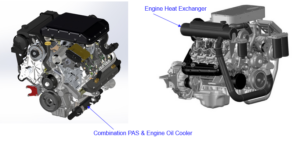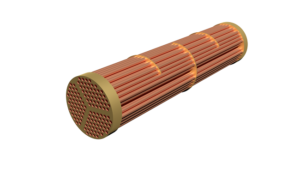Replacement Marine Heat Exchangers
Marine heat exchangers are vital components of any marine cooling system. They play a crucial role in maintaining the optimal performance of marine vessels.
However, like any other mechanical component, marine heat exchangers are subject to wear and tear. Over time, they may require replacement to ensure the efficiency of your marine cooling system.
Knowing when and how to replace your marine heat exchanger can be a daunting task. Especially if you’re not familiar with the intricacies of marine engineering.
This article aims to guide you through the process. From identifying the signs that indicate a need for replacement, to selecting and installing the right replacement marine heat exchanger.
Whether you’re a boat owner, a marine engineer, or a ship maintenance personnel, this guide will provide you with the necessary information.
Understanding Marine Heat Exchangers
Marine heat exchangers are devices designed to transfer heat between two or more fluids. They are a key component in marine cooling systems.
Their primary function is to cool the engine and other onboard equipment. They do this by transferring heat from these systems to the seawater.
The efficiency of a marine heat exchanger is crucial. It directly impacts the performance and fuel efficiency of the vessel’s engine.
However, the marine environment poses unique challenges. Corrosion and fouling are common issues that can affect the performance and lifespan of marine heat exchangers.
Understanding these challenges is the first step towards effective maintenance and timely replacement.
Types of Marine Heat Exchangers
There are several types of marine heat exchangers. The most common ones are shell and tube, plate, and air-cooled heat exchangers.
Shell and tube heat exchangers are widely used due to their robustness and high heat transfer efficiency. They consist of a series of tubes enclosed in a shell.
Plate heat exchangers, on the other hand, are compact and efficient. They consist of a series of thin, corrugated plates stacked together.
Air-cooled heat exchangers use air instead of water to cool the engine. They are ideal for applications where water is scarce or expensive.
Signs You Need a Replacement
Identifying the signs that indicate a need for replacement is crucial. It helps prevent costly repairs and downtime.
One common sign is a decrease in cooling efficiency. This could be due to fouling or corrosion inside the heat exchanger.
Another sign is visible damage or leaks. If you notice any of these signs, it’s time to consider a replacement.
Selecting the Right Replacement
Choosing the right replacement marine heat exchanger is crucial. It ensures optimal performance and longevity of your marine cooling system.
First, consider the type of heat exchanger that best suits your needs. This depends on factors like the type of vessel, its size, and the specific cooling requirements.
Next, consider the material of the heat exchanger. It should be resistant to corrosion and fouling, common issues in marine environments.
Finally, consider the size and compatibility of the heat exchanger. It should fit well with your existing marine cooling system.
- Type of heat exchanger
- Material
- Size and compatibility
Material Considerations for Marine Environments
The material of the heat exchanger is a key consideration. It should be able to withstand the harsh marine environment.
Commonly used materials include titanium and cupronickel. Titanium is known for its excellent corrosion resistance, while cupronickel is valued for its anti-fouling properties.
Choosing the right material can significantly extend the lifespan of your marine heat exchanger.
Sizing and Compatibility
The size of the heat exchanger should match your cooling requirements. A heat exchanger that is too small may not provide sufficient cooling, while one that is too large may be inefficient.
Compatibility with your existing marine cooling system is also important. The replacement heat exchanger should fit well and work seamlessly with the other components.
Remember, a well-chosen replacement can enhance the performance and efficiency of your marine cooling system.
Installation and Maintenance
Once you’ve selected the right replacement, the next step is installation. This process can be complex, so it’s often best to consult with a marine engineering expert.
Proper installation ensures optimal performance and longevity of the heat exchanger. It also helps prevent issues like leaks and overheating.
After installation, regular maintenance is crucial. This includes routine inspections, cleaning, and descaling to keep the heat exchanger in good condition.
Step-by-Step Replacement Guide
Replacing a marine heat exchanger involves several steps. First, you need to disconnect the old heat exchanger from the cooling system.
Next, remove the old heat exchanger and install the new one. Ensure it’s properly aligned and securely fastened.
Finally, reconnect the new heat exchanger to the cooling system. Check for leaks and ensure it’s functioning properly before resuming normal operation.
Maintenance Tips for Longevity
Regular maintenance can significantly extend the lifespan of your marine heat exchanger. This includes routine inspections to detect any signs of wear or damage.
Also, regular cleaning and descaling can prevent fouling and corrosion, common issues in marine environments. This helps maintain the efficiency and performance of the heat exchanger.
Legal and Environmental Considerations
When replacing marine heat exchangers, it’s important to consider legal and environmental regulations. These can vary by region and type of vessel.
For instance, some regulations require specific materials or designs to minimize environmental impact. Always ensure your replacement heat exchanger complies with all relevant laws and guidelines.
Innovations and Trends in Marine Heat Exchangers
The field of marine heat exchangers is constantly evolving. New materials and designs are being developed to improve efficiency and durability.
Innovations like smart monitoring technologies and energy recovery systems are shaping the future of marine cooling systems. Staying informed about these trends can help you make the best choice for your vessel.
Conclusion: Ensuring Optimal Performance and Longevity
Choosing the right replacement marine heat exchanger is crucial for the performance and longevity of your vessel’s cooling system. Regular maintenance and understanding of your system’s needs will ensure optimal operation.
Stay informed about the latest trends and innovations in marine heat exchangers to make the best decisions for your vessel.


